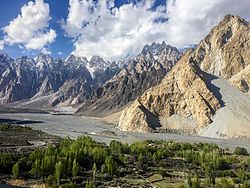Passu
This article needs additional citations for verification. (November 2018) |
Passu
پسو | |
|---|---|
 Tupopdan and the Hunza River, from the Karakoram Highway in Passu, Pakistan | |
| Coordinates: 36°28′N 74°54′E / 36.467°N 74.900°E | |
| Province | |
| Time zone | UTC+5 |
Passu (Urdu: پسو) is a small village situated in the Gojal valley of Upper Hunza in the Gilgit Baltistan region of Northern Pakistan. Located along the Karakoram Highway, Passu is a renowned tourist destination. The village is celebrated for its landscapes and breathtaking views of the 7,478-meter (24,534 ft) Passu Sar mountain, the Passu Glacier, and Tupopdan 6,106m (20,033 ft).
Geography[edit]
Passu is situated along the Hunza River, approximately 20 kilometres (12 mi) from Gulmit,[1] the tehsil headquarters of Gojal. It is about 147 kilometres (91 mi) upriver from Gilgit.[2] Passu lies in the Gojal Valley, within the subdivision of District Hunza.
It lies very near the tongue of the Passu Glacier, and just south of the tongue of the Batura Glacier. The latter is the seventh-longest non-polar glacier in the world at 56 kilometres (35 mi), and reaches very near to the highway. Borith Lake is a large water feature below the Hussaini village in the area.[3]
Tupopdan 6,106 metres (20,033 ft) also known as 'Passu Cones' or 'Passu Cathedral', lies to the north of the Passu village in Gojal Valley. It is the most photographed peak of the region.[4] Also nearby are the high peaks of Pasu Sar, Shispare Sar, and Batura.
Demographics[edit]
The people are predominantly Wakhi[5] and speak the Wakhi language. They are Ismaili, a sect of Shia Islam.
See also[edit]
References[edit]
- ^ "Passu on map". Google Maps. Retrieved 18 September 2019.
- ^ "Distance from Gilgit to Passu". Google Map. Retrieved 18 September 2019.
- ^ "Hike Passu - Lake Borit - Hike between two glaciers | Gigaplaces.com".
- ^ Taylor, Alan (27 November 2017). "A Photo Trip Along the Ancient Silk Road". The Atlantic. Retrieved 18 September 2019.
- ^ Salopek, Paul (2 January 2018). "Walking Grass". National Geographic. Retrieved 2 January 2018.
The inhabitants of this austere landscape, many of them ethnic Wakhi farmers, have learned to trap this explosive blessing through the filter of grass.

